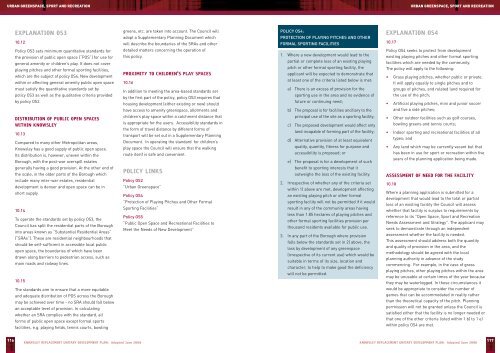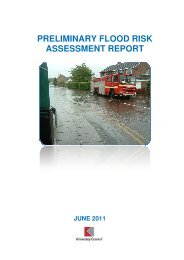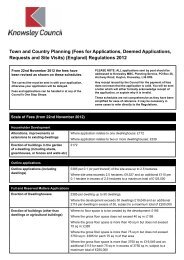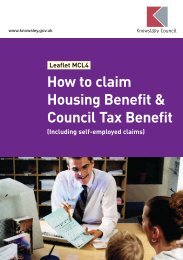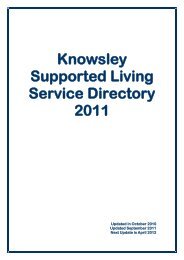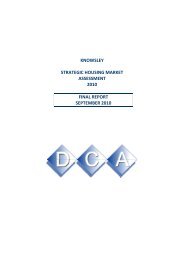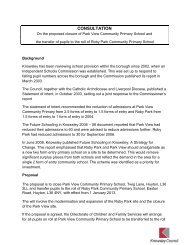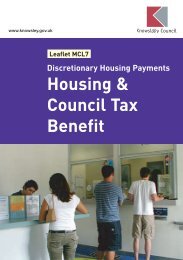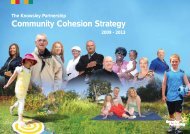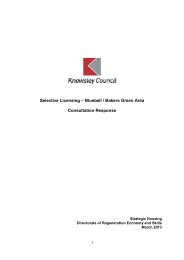Knowsley Replacement Unitary Development Plan - Knowsley Council
Knowsley Replacement Unitary Development Plan - Knowsley Council
Knowsley Replacement Unitary Development Plan - Knowsley Council
You also want an ePaper? Increase the reach of your titles
YUMPU automatically turns print PDFs into web optimized ePapers that Google loves.
URBAN GREENSPACE, SPORT AND RECREATION<br />
URBAN GREENSPACE, SPORT AND RECREATION<br />
EXPLANATION OS3<br />
10.12<br />
Policy OS3 sets minimum quantitative standards for<br />
the provision of public open space (“POS”) for use for<br />
general amenity or children’s play. It does not cover<br />
playing pitches and other formal sporting facilities,<br />
which are the subject of policy OS4. New development<br />
within or affecting general amenity public open space<br />
must satisfy the quantitative standards set by<br />
policy OS3 as well as the qualitative criteria provided<br />
by policy OS2.<br />
DISTRIBUTION OF PUBLIC OPEN SPACES<br />
WITHIN KNOWSLEY<br />
10.13<br />
Compared to many other Metropolitan areas,<br />
<strong>Knowsley</strong> has a good supply of public open space.<br />
Its distribution is, however, uneven within the<br />
Borough, with the post-war overspill estates<br />
generally having a good provision. At the other end of<br />
the scale, in the older parts of the Borough which<br />
include many inter-war estates, residential<br />
development is denser and open space can be in<br />
short supply.<br />
10.14<br />
To operate the standards set by policy OS3, the<br />
<strong>Council</strong> has split the residential parts of the Borough<br />
into areas known as “Substantial Residential Areas”<br />
(“SRAs”). These are residential neighbourhoods that<br />
should be self-sufficient in accessible local public<br />
open space, the boundaries of which have been<br />
drawn along barriers to pedestrian access, such as<br />
main roads and railway lines.<br />
10.15<br />
The standards aim to ensure that a more equitable<br />
and adequate distribution of POS across the Borough<br />
may be achieved over time - no SRA should fall below<br />
an acceptable level of provision. In calculating<br />
whether an SRA complies with the standard, all<br />
forms of public open space except formal sports<br />
facilities, e.g. playing fields, tennis courts, bowling<br />
greens, etc. are taken into account. The <strong>Council</strong> will<br />
adopt a Supplementary <strong>Plan</strong>ning Document which<br />
will describe the boundaries of the SRAs and other<br />
detailed matters concerning the operation of<br />
this policy.<br />
PROXIMITY TO CHILDREN’S PLAY SPACES<br />
10.16<br />
In addition to meeting the area-based standards set<br />
by the first part of the policy, policy OS3 requires that<br />
housing development (either existing or new) should<br />
have access to amenity greenspace, allotments and<br />
children’s play space within a catchment distance that<br />
is appropriate for the users. Accessibility standards in<br />
the form of travel distance by different forms of<br />
transport will be set out in a Supplementary <strong>Plan</strong>ning<br />
Document. In operating the standard for children’s<br />
play space the <strong>Council</strong> will ensure that the walking<br />
route itself is safe and convenient.<br />
POLICY LINKS<br />
Policy OS2<br />
“Urban Greenspace”<br />
Policy OS4<br />
“Protection of Playing Pitches and Other Formal<br />
Sporting Facilities”<br />
Policy OS5<br />
“Public Open Space and Recreational Facilities to<br />
Meet the Needs of New <strong>Development</strong>”<br />
POLICY OS4:<br />
PROTECTION OF PLAYING PITCHES AND OTHER<br />
FORMAL SPORTING FACILITIES<br />
1. Where a new development would lead to the<br />
partial or complete loss of an existing playing<br />
pitch or other formal sporting facility, the<br />
applicant will be expected to demonstrate that<br />
at least one of the criteria listed below is met:<br />
a) There is an excess of provision for the<br />
sporting use in the area and no evidence of<br />
future or continuing need;<br />
b) The proposal is for facilities ancillary to the<br />
principal use of the site as a sporting facility;<br />
c) The proposed development would affect only<br />
land incapable of forming part of the facility;<br />
d) Alternative provision of at least equivalent<br />
quality, quantity, fitness for purpose and<br />
accessibility is proposed; or<br />
e) The proposal is for a development of such<br />
benefit to sporting interests that it<br />
outweighs the loss of the existing facility.<br />
2. Irrespective of whether any of the criteria set<br />
within 1) above are met, development affecting<br />
an existing playing pitch or other formal<br />
sporting facility will not be permitted if it would<br />
result in any of the community areas having<br />
less than 1.85 hectares of playing pitches and<br />
other formal sporting facilities provision per<br />
thousand residents available for public use.<br />
3. In any part of the Borough where provision<br />
falls below the standards set in 2) above, the<br />
loss by development of any greenspace<br />
(irrespective of its current use) which would be<br />
suitable in terms of its size, location and<br />
character, to help to make good the deficiency<br />
will not be permitted.<br />
EXPLANATION OS4<br />
10.17<br />
Policy OS4 seeks to protect from development<br />
existing playing pitches and other formal sporting<br />
facilities which are needed by the community.<br />
The policy will apply to the following:<br />
• Grass playing pitches, whether public or private.<br />
It will apply equally to single pitches and to<br />
groups of pitches, and related land required for<br />
the use of the pitch;<br />
• Artificial playing pitches, mini and junior soccer<br />
and five a side pitches;<br />
• Other outdoor facilities such as golf courses,<br />
bowling greens and tennis courts;<br />
• Indoor sporting and recreational facilities of all<br />
types; and<br />
• Any land which may be currently vacant but that<br />
has been in use for sport or recreation within five<br />
years of the planning application being made.<br />
ASSESSMENT OF NEED FOR THE FACILITY<br />
10.18<br />
Where a planning application is submitted for a<br />
development that would lead to the total or partial<br />
loss of an existing facility the <strong>Council</strong> will assess<br />
whether that facility is surplus to requirements by<br />
reference to its "Open Space, Sport and Recreation<br />
Needs Assessment and Strategy". The applicant may<br />
seek to demonstrate through an independent<br />
assessment whether the facility is needed.<br />
This assessment should address both the quantity<br />
and quality of provision in the area, and the<br />
methodology should be agreed with the local<br />
planning authority in advance of the study<br />
commencing. For example, in the case of grass<br />
playing pitches, other playing pitches within the area<br />
may be unusable at certain times of the year because<br />
they may be waterlogged. In these circumstances it<br />
would be appropriate to consider the number of<br />
games that can be accommodated in reality rather<br />
than the theoretical capacity of the pitch. <strong>Plan</strong>ning<br />
permission will not be granted unless the <strong>Council</strong> is<br />
satisfied either that the facility is no longer needed or<br />
that one of the other criteria listed within 1 b) to 1 e)<br />
within policy OS4 are met.<br />
116<br />
KNOWSLEY REPLACEMENT UNITARY DEVELOPMENT PLAN: Adopted June 2006<br />
KNOWSLEY REPLACEMENT UNITARY DEVELOPMENT PLAN: Adopted June 2006<br />
117


